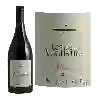
Domaine MirabelLes Éboulis
In the mouth this red wine is a powerful with a nice balance between acidity and tannins.
This wine generally goes well with beef, veal or pasta.
Taste structure of the Les Éboulis from the Domaine Mirabel
Light | Bold | |
Smooth | Tannic | |
Dry | Sweet | |
Soft | Acidic |
In the mouth the Les Éboulis of Domaine Mirabel in the region of Languedoc-Roussillon is a powerful with a nice balance between acidity and tannins.
Food and wine pairings with Les Éboulis
Pairings that work perfectly with Les Éboulis
Original food and wine pairings with Les Éboulis
The Les Éboulis of Domaine Mirabel matches generally quite well with dishes of beef, pasta or veal such as recipes of fresh sausage, pork sautéed with chinese noodles or veal paupiettes with cider.
Details and technical informations about Domaine Mirabel's Les Éboulis.
Discover the grape variety: Tchilar
It is certainly one of the best grape varieties in Armenia, where it originates.
Informations about the Domaine Mirabel
The Domaine Mirabel is one of of the world's greatest estates. It offers 9 wines for sale in the of Pic-Saint-Loup to come and discover on site or to buy online.
The wine region of Pic-Saint-Loup
The wine region of Pic-Saint-Loup is located in the region of Languedoc of Languedoc-Roussillon of France. Wineries and vineyards like the Domaine Ermitage du Pic Saint Loup or the Domaine de Villeneuve produce mainly wines red, pink and white. The most planted grape varieties in the region of Pic-Saint-Loup are Mourvèdre, Roussanne and Viognier, they are then used in wines in blends or as a single variety. On the nose of Pic-Saint-Loup often reveals types of flavors of earth, straw or apricot and sometimes also flavors of peach, dark chocolate or anise.
The wine region of Languedoc-Roussillon
Languedoc (formerly Coteaux du Languedoc) is a key appellation used in the Languedoc-Roussillon wine region of southern France. It covers Dry table wines of all three colors (red, white and rosé) from the entire region, but leaves Sweet and Sparkling wines to other more specialized appellations. About 75% of all Languedoc wines are red, with the remaining 25% split roughly down the middle between whites and rosés. The appellation covers most of the Languedoc region and almost a third of all the vineyards in France.
The word of the wine: Biodynamics
Biodynamic farming method initiated by Rudolf Steiner which forbids all chemical treatments based on synthetic products. Biodynamics is based on the interaction between the movements of the planets and the development of plants and uses preparations based on organic and mineral materials.














